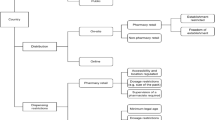Abstract
Objective: New Zealand has a class of drugs (Restricted Medicines) which are available over the counter in pharmacies, but must be sold by qualified pharmacists. Patient names must be recorded for each sale. Many restricted medicines have recently been reclassified from prescription only, with the expectation that pharmacists provide professional input into their sale. The study described here explored whether pharmacists do fulfil this expectation.Method: In late 1999, 12 mystery shoppers made 360 visits to 180 pharmacies around New Zealand. Shoppers were of different ages, genders, ethnic and socio-economic backgrounds. Two kinds of products were purchased: diclofenac 25 mg, which was requested for "back pain" and vaginal anti-fungals requested for "thrush". Main outcome measure: The main outcome measure described here is whether the shoppers received specified items of counselling. These included questions about the shopper's health status, contraindications to medicine use, advice about the use of the product and the health problem presented. Other outcome measures are whether sales of restricted medicines were carried out by pharmacists or other staff, and whether sales were recorded.Results: In spite of the requirement that pharmacists sell restricted medicines, shoppers often found it difficult to distinguish pharmacists from other pharmacy staff. Shoppers were able to confirm that a pharmacist was definitely involved in only 46% of visits. In 8.8% of the diclofenac visits, and 10.8% of the visits for vaginal anti-fungals, no counselling was provided. The vaginal anti-fungal visits tended to be more product-focussed than the diclofenac visits. When they purchased diclofenac, most pharmacists asked shoppers if they had, or had had, stomach problems (74.6%) or asthma (65.4%). A minority asked about the symptoms of the vaginal fungal infection which the female shoppers presented with. While most pharmacies recorded patient names, many did so in a way which compromised patient confidentiality.Conclusion: Pharmacies varied widely in the amount of counselling they provided to people purchasing restricted medicines.
Similar content being viewed by others
References
Bessell T, Hiller J, Sansom L. 'Pharmacist only' medicines. Aust N Z J Public Health 1999;23(6):661-2.
MedSafe, Ministry of Health, New Zealand. www.medsafe.govt.nz/profs/class/class1.htm.
Pharmaceutical Society of New Zealand. PSNZ Pharmacy Practice Handbook. Wellington, New Zealand: Pharmaceutical Society of New Zealand, 1998.
Pharmaceutical Society of New Zealand. Pharmacist Only Medicines (Restricted Medicines). Wellington, New Zealand: 2001.
Anon. Can you rely on your pharmacist? Consumer (magazine of the New Zealand Consumers' Institute) 1996(346):6-9.
Anon. Pharmacists in crisis. Which? 1996(January):18-21.
Anon. Counter advice. Which? 1999(April):22-5.
Vanderveen R, Adams C, Sanborn M. The pharmacist as a drug consultant-five years later. Drug Intelligence Clin Pharm 1978;12(Dec):718-9.
Mickle R, Self T, Farr G, Bess D, Tsiu S, Caldwell F. Evaluation of pharmacists' practice in patient education when dispensing a metered-dose inhaler. DICP Ann Pharmacother 1990;24(October):927-30.
Mason H, Svarstad B. Medication counseling behaviour and attitudes of rural community pharmacists. Drug Intelligence Clin Pharm 1984;18(May):409-14.
Lamsam GD, Kropff MA. Community pharmacists' assessments and recommendations for treatment in four case scenarios. Ann Pharmacother 1998;32:409-16.
Willison DJ, Muzzin LJ. Workload, data gathering, and quality of community pharmacists' advice. Med Care 1995; 33(1):29-40.
Linn L. Indicated versus actual behaviour-the pharmacist as health advisor. Soc Sci Med 1973;7:191-7.
Eng H, Bulfer B, Doering P, Kimberlin C. Assessment of the Florida pharmacist self-care consultant law using a trained shopper method. J Pharm Marketing Manage 1991;5(4):27-52.
Watkins R, Norwood G, Meister F. Improving the quality of the pharmacist as a drug advisor to patients and physicians through continuing education. Am J Pharmaceut Education 1976;40:34-9.
Anderson C. A Controlled study of the effect of a health promotion training scheme on pharmacists' advice about smoking cessation. J Soc Admin Pharm 1995;12(3):115-23.
de Almeida Neto, AC, Benrimoj, SI, Kavanagh, DJ, Boakes, RA. Novel educational training program for community pharmacists. Am J Pharmaceut Education 2000;64:302-7.
Tomson G, Sterky G. Self-prescribing by way of pharmacies in three Asian developing countries. Lancet 1986; 2(8507):620-2.
Goel P, Ross-Degnan D, McLaughlin T, Soumerai S. Influence of location and staff knowledge on quality of retail pharmacy prescribing for childhood diarrhea in Kenya. International J Qual Health Care 1996;8(6):519-62.
Leyva-F R, Bronfman-P M, Erviti-E J. Simulated clients in drugstores: prescriptive behaviour of drugstore attendants. J Soc Admin Pharm 2000;17(3):151-8.
Plumridge E, McCool J, Chetwynd J, Langley J. Purchasing a cycle helmet: are retailers providing adequate advice? Injury Prev 1996;2:41-3.
Brown C, Sopp L, Gould S. Consumers' association goes undercover. Consumer Pol Rev 1997;7(1):2-6.
Yinger J. Evidence on discrimination in consumer markets. J Econ Perspect 1998;12(2):23-40.
Darity W, Mason P. Evidence on Discrimination in employment: codes of color, codes of gender. J Econ Perspect 1998;12(2):63-90.
Ayres I. Fair Driving: Gender and race discrimination in retail car negotiations. Harvard Law Rev 1991;104(4):818-72.
Madden J, Quick J, Ross-Degnan D, Kafle K. Undercover careseekers: simulated clients in the study of health provider behavior in developing countries. So Sci Med 1997;45(10):1465-82.
Pharmacy Act 1970. An act to consolidate and amend the law relating to the registration and control of pharmacists and to the practice of pharmacy. New Zealand: 1970.
Wickins K, Fitzharris P, Crane J. Increasing asthma prevalence in New Zealand: understanding the causes. N Z Public Health Rep 1998;5(3):17-20.
Author information
Authors and Affiliations
Rights and permissions
About this article
Cite this article
Norris, P.T. Purchasing restricted medicines in New Zealand pharmacies: results from a "mystery shopper" study. Pharm World Sci 24, 149–153 (2002). https://doi.org/10.1023/A:1019506120713
Issue Date:
DOI: https://doi.org/10.1023/A:1019506120713




